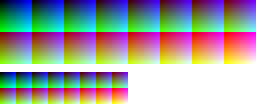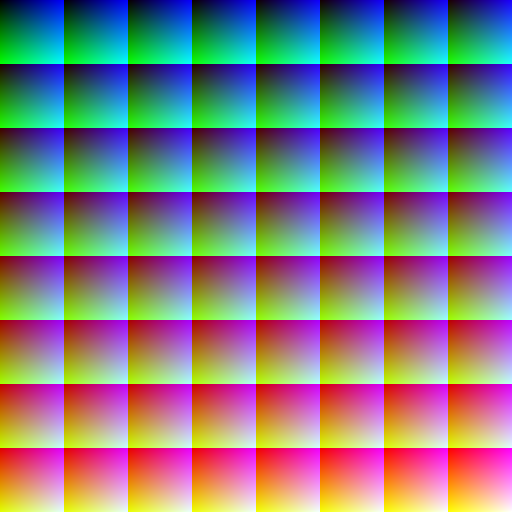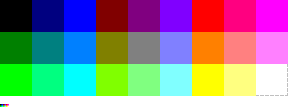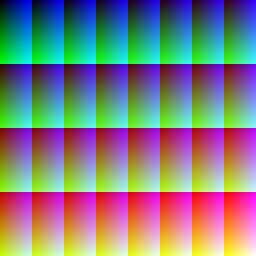
List of monochrome and RGB palettes
Encyclopedia
-
-
- For a full listing of computer's color palettes, see List of palettes
-
This list of monochrome and RGB palettes includes generic repertoires of colors (color palette
Palette (computing)
In computer graphics, a palette is either a given, finite set of colors for the management of digital images , or a small on-screen graphical element for choosing from a limited set of choices, not necessarily colors .Depending on the context In computer graphics, a palette is either a given,...
s) to produce black-and-white
Black-and-white
Black-and-white, often abbreviated B/W or B&W, is a term referring to a number of monochrome forms in visual arts.Black-and-white as a description is also something of a misnomer, for in addition to black and white, most of these media included varying shades of gray...
and RGB color pictures by a computer's display hardware
Computer hardware
Personal computer hardware are component devices which are typically installed into or peripheral to a computer case to create a personal computer upon which system software is installed including a firmware interface such as a BIOS and an operating system which supports application software that...
, not necessarily the total number of such colors that can be simultaneously displayed in a given text or graphic mode of any machine. RGB is the most common method to produce colors for displays; so these complete RGB color repertoires have every possible combination of R-G-B triplets within any given maximum number of levels per component.
For specific hardware and different methods to produce colors other than RGB, see the List of 8-bit computer hardware palettes, the List of 16-bit computer hardware palettes and the List of videogame consoles palettes. For various software arrangements and sorts of colors, including other possible full RGB arrangements within 8-bit color depth
Color depth
In computer graphics, color depth or bit depth is the number of bits used to represent the color of a single pixel in a bitmapped image or video frame buffer. This concept is also known as bits per pixel , particularly when specified along with the number of bits used...
displays, see the List of software palettes.
Each palette is represented by a series of color patches. When the number of colors is low, a 1-pixel-size version of the palette appears below it, for easily comparing relative palette sizes. Huge palettes are given directly in one-color-per-pixel color patches.
For each unique palette, an image color test chart and sample image (truecolor original follows) rendered with that palette (without dithering) are given. The test chart shows the full 256 levels of the red, green, and blue (RGB) primary colors and cyan, magenta, and yellow complementary colors, along with a full 256-level grayscale. Gradients of RGB intermediate colors (orange, lime green, sea green, sky blue, violet, and fuchsia), and a full hue
Hue
Hue is one of the main properties of a color, defined technically , as "the degree to which a stimulus can be describedas similar to or different from stimuli that are described as red, green, blue, and yellow,"...
spectrum are also present. Color charts are not gamma
Gamma correction
Gamma correction, gamma nonlinearity, gamma encoding, or often simply gamma, is the name of a nonlinear operation used to code and decode luminance or tristimulus values in video or still image systems...
corrected.
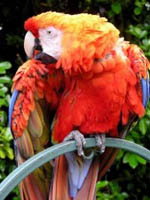 |
 |
These elements illustrate the color depth and distribution of the colors of any given palette, and the sample image indicates how the color selection of such palettes could represent real-life images. These images are not necessarily representative of how the image would be displayed on the original graphics hardware, as the hardware may have additional limitations regarding the maximum display resolution
Display resolution
The display resolution of a digital television or display device is the number of distinct pixels in each dimension that can be displayed. It can be an ambiguous term especially as the displayed resolution is controlled by all different factors in cathode ray tube , flat panel or projection...
, pixel aspect ratio
Pixel aspect ratio
Pixel aspect ratio is a mathematical ratio that describes how the width of a pixel in a digital image compares to the height of that pixel....
and color placement. For simulated sample images for notable computers, see the List of 8-bit computer hardware palettes and List of 16-bit computer hardware palettes articles.
Monochrome palettes
These palettes only have some shades of gray, from black to white, both considered the most possible darker and lighter "grays", respectively. The general rule is that those palettes have 2n different shades of gray, where n is the number of bits needed to represent a single pixelPixel
In digital imaging, a pixel, or pel, is a single point in a raster image, or the smallest addressable screen element in a display device; it is the smallest unit of picture that can be represented or controlled....
.
Monochrome (1-bit)
MonochromeMonochrome
Monochrome describes paintings, drawings, design, or photographs in one color or shades of one color. A monochromatic object or image has colors in shades of limited colors or hues. Images using only shades of grey are called grayscale or black-and-white...
graphics displays typically have a black background with a white or light gray image, though green and amber monochrome monitor
Monochrome monitor
A monochrome monitor is a type of CRT computer display which was very common in the early days of computing, from the 1960s through the 1980s, before color monitors became popular. They are still widely used in applications such as computerized cash register systems...
s were also common. Such a palette requires only one bit per pixel.
 |
 |
Where photo-realism was desired, these early computer systems had a heavy reliance on dithering to make up for the limits of the technology.
In some systems, as Hercules
Hercules Graphics Card
The Hercules Graphics Card was a computer graphics controller made by Hercules Computer Technology, Inc. which, through its popularity, became a widely supported display standard. It was common on IBM PC compatibles connected to a monochrome monitor . It supported one high resolution text mode and...
and CGA
Color Graphics Adapter
The Color Graphics Adapter , originally also called the Color/Graphics Adapter or IBM Color/Graphics Monitor Adapter, introduced in 1981, was IBM's first color graphics card, and the first color computer display standard for the IBM PC....
graphic cards for the IBM PC
IBM PC
The IBM Personal Computer, commonly known as the IBM PC, is the original version and progenitor of the IBM PC compatible hardware platform. It is IBM model number 5150, and was introduced on August 12, 1981...
, a bit value of 1 represents white pixels (light on) and a value of 0 the black ones (light off); others, like the Atari ST
Atari ST
The Atari ST is a home/personal computer that was released by Atari Corporation in 1985 and commercially available from that summer into the early 1990s. The "ST" officially stands for "Sixteen/Thirty-two", which referred to the Motorola 68000's 16-bit external bus and 32-bit internals...
and Apple Macintosh with monochrome monitors, a bit value of 0 means a white pixel (no ink) and a value of 1 means a black pixel (dot of ink), which it approximates to the printing logic.
2-bit Grayscale
In a 2-bit color palette each pixel's value is represented by 2 bits resulting in a 4-value palette (22 = 4).  |
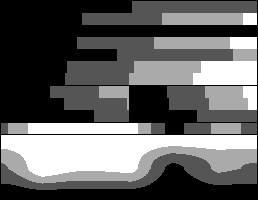 |
2-bit dithering:
It has black, white and two intermediate levels of gray as follows:
A monochrome 2-bit palette is used on:
- NeXT ComputerNeXT ComputerThe NeXT Computer was a high-end workstation computer developed, manufactured and sold by Steve Jobs' company NeXT from 1988 until 1990. It ran the Unix-based NeXTSTEP operating system. The NeXT Computer was packaged in a 1-foot die-cast magnesium cube-shaped case, which led to the machine being...
, NeXTcubeNeXTcubeThe NeXTcube was a high-end workstation computer developed, manufactured and sold by NeXT from 1990 until 1993. It superseded the original NeXT Computer workstation and was housed in a similar cube-shaped magnesium enclosure. The workstation ran the NeXTSTEP operating system.- Hardware :The...
and NeXTstationNeXTstationNeXTstation was a high-end workstation computer developed, manufactured and sold by NeXT from 1990 until 1993. It ran the NeXTSTEP operating system. The NeXTstation was released as a more affordable alternative to the NeXTcube at about US $4,995 or about half the price...
monochrome graphic displays. - Original Game BoyGame BoyThe , is an 8-bit handheld video game device developed and manufactured by Nintendo. It was released in Japan on , in North America in , and in Europe on...
system portable videogame console. - Macintosh PowerBook 150PowerBook 150The PowerBook 150 was a laptop created by Apple Computer in 1994. It was the last member of the PowerBook 100 series to use the original case design, the most affordable of the series when introduced, and also the last consumer model. It was 8 MHz faster than its predecessor, the PowerBook 145B...
monochrome LCD displays. - Commodore Amiga with A2024 monochrome monitor in high-resolution mode.
- The original Amazon KindleAmazon KindleThe Amazon Kindle is an e-book reader developed by Amazon.com subsidiary Lab126 which uses wireless connectivity to enable users to shop for, download, browse, and read e-books, newspapers, magazines, blogs, and other digital media...
- Texas InstrumentsTexas InstrumentsTexas Instruments Inc. , widely known as TI, is an American company based in Dallas, Texas, United States, which develops and commercializes semiconductor and computer technology...
TI-89 seriesTI-89 seriesThe TI-89 and the TI-89 Titanium are graphing calculators developed by Texas Instruments. They are differentiated from most other TI graphing calculators by their computer algebra system, which allows symbolic manipulation of algebraic expressions...
calculators with third-party software
4-bit Grayscale
In a 4-bit color palette each pixel's value is represented by 4 bits resulting in a 16-value palette (24 = 16):  |
 |
4-bit grayscale dithering does a fairly good job of reducing visible banding of the level changes:
A monochrome 4-bit palette is used on:
- MOS Technology VDC (on the Commodore 128Commodore 128The Commodore 128 home/personal computer was the last 8-bit machine commercially released by Commodore Business Machines...
with monochrome monitor)
8-bit Grayscale
 |
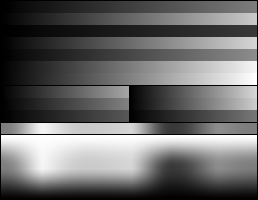 |
In a 8-bit color palette each pixel's value is represented by 8 bits resulting in a 256-value palette (28 = 256). This is usually the maximum number of grays in ordinary monochrome systems; each image pixel occupies a single memory byte
Byte
The byte is a unit of digital information in computing and telecommunications that most commonly consists of eight bits. Historically, a byte was the number of bits used to encode a single character of text in a computer and for this reason it is the basic addressable element in many computer...
.
Most scanner
Image scanner
In computing, an image scanner—often abbreviated to just scanner—is a device that optically scans images, printed text, handwriting, or an object, and converts it to a digital image. Common examples found in offices are variations of the desktop scanner where the document is placed on a glass...
s can capture images in 8-bit grayscale, and image file formats like TIFF and JPEG
JPEG
In computing, JPEG . The degree of compression can be adjusted, allowing a selectable tradeoff between storage size and image quality. JPEG typically achieves 10:1 compression with little perceptible loss in image quality....
natively support this monochrome palette size.
Alpha channels employed for video overlay also use (conceptually) this palette. The gray level indicates the opacity of the blended image pixel over the background image pixel.
Regular RGB palettes
Here are grouped those full RGB hardware palettes that have the same number of binary levels (i.e., the same number of bitBit
A bit is the basic unit of information in computing and telecommunications; it is the amount of information stored by a digital device or other physical system that exists in one of two possible distinct states...
s) for every red, green and blue components using the full RGB color model. Thus, the total number of colors are always the number of possible levels by component, n, raised to a power of 3: n×n×n = n3.
3-bit RGB
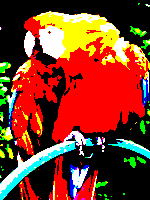 |
 |
3-bit RGB dithering:
Systems with a 3-bit RGB palette use 1 bit for each of the red, green and blue color components. That is, each component is either "on" or "off" with no intermediate states. This results in an 8-color palette (23 = 8) that have black, white, the three RGB primary colors red, blue and green and their correspondent complementary colors cyan, magenta and yellow as follows:
The color indices vary between implementations; therefore, index numbers are not given.
The 3-bit RGB palette is used by:
- The ECMA-48 standard for text terminals (sometimes known as the "ANSI standard", although ANSI X3.64 does not define colors)
- TeletextTeletextTeletext is a television information retrieval service developed in the United Kingdom in the early 1970s. It offers a range of text-based information, typically including national, international and sporting news, weather and TV schedules...
standards since 1976 - VideotexVideotexVideotex was one of the earliest implementations of an "end-user information system". From the late 1970s to mid-1980s, it was used to deliver information to a user in computer-like format, typically to be displayed on a television.In a strict definition, videotex refers to systems that provide...
- TRS-80 Color ComputerTRS-80 Color ComputerThe Radio Shack TRS-80 Color Computer was a home computer launched in 1980. It was one of the earliest of the first generation of computers marketed for home use in English-speaking markets...
(in graphics mode, only 4 colors can be displayed simultaneously from fixed 4-colors palettes) - Oric
- BBC MicroBBC MicroThe BBC Microcomputer System, or BBC Micro, was a series of microcomputers and associated peripherals designed and built by Acorn Computers for the BBC Computer Literacy Project, operated by the British Broadcasting Corporation...
6-bit RGB
 |
 |
Systems with a 6-bit RGB palette use 2 bits for each of the red, green, and blue color components. This results in a 43 = 64-color palette as follows:
6-bit RGB systems include the following:
- Enhanced Graphics AdapterEnhanced Graphics AdapterThe Enhanced Graphics Adapter is the IBM PC computer display standard specification which is between CGA and VGA in terms of color and space resolution. Introduced in October 1984 by IBM shortly after its new PC/AT, EGA produces a display of 16 simultaneous colors from a palette of 64 at a...
(EGA) for IBM PC/ATIBM Personal Computer/ATThe IBM Personal Computer AT, more commonly known as the IBM AT and also sometimes called the PC AT or PC/AT, was IBM's second-generation PC, designed around the 6 MHz Intel 80286 microprocessor and released in 1984 as machine type 5170...
(only 16 colors can be displayed simultaneously) - Sega Master SystemSega Master SystemThe is a third-generation video game console that was manufactured and released by Sega in 1985 in Japan , 1986 in North America and 1987 in Europe....
videogame console
9-bit RGB
 |
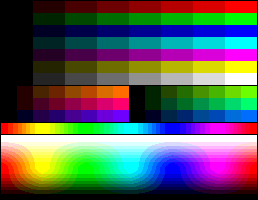 |
Systems with a 9-bit RGB palette use 3 bits for each of the red, green, and blue color components. This results in a 83 = 512-color palette as follows:
9-bit RGB systems include the following:
- Atari STAtari STThe Atari ST is a home/personal computer that was released by Atari Corporation in 1985 and commercially available from that summer into the early 1990s. The "ST" officially stands for "Sixteen/Thirty-two", which referred to the Motorola 68000's 16-bit external bus and 32-bit internals...
- Sega Genesis videogame console
- MSX2 computer (also MSX2+ and MSX Turbo R)
- Sega NomadSega NomadThe Sega Nomad was a handheld game console sold for the North American consumer market which played Mega Drive/Genesis game cartridges. The system was similar to the Japanese Sega Mega Jet, but featured a built-in color screen; the Mega Jet needed a separate monitor...
- TurboGrafx-16TurboGrafx-16TurboGrafx-16, fully titled as TurboGrafx-16 Entertainment SuperSystem and known in Japan as the , is a video game console developed by Hudson Soft and NEC, released in Japan on October 30, 1987, and in North America on August 29, 1989....
12-bit RGB
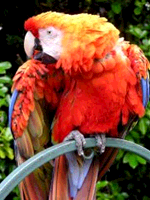 |
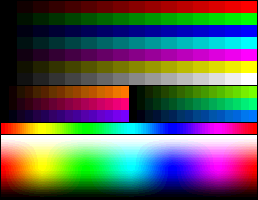 |
Systems with a 12-bit RGB palette use 4 bits for each of the red, green, and blue color components. This results in a 163 = 4096-color palette as follows:
12-bit RGB systems include the following:
- Amiga Original chipset (OCS)
- Apple IIgsApple IIGSThe Apple , the fifth and most powerful model in the Apple II series of personal computers produced by Apple Computer. The "GS" in the name stands for Graphics and Sound, referring to its enhanced graphics and sound capabilities, both of which greatly surpassed previous models of the line...
Video Graphics Chip - The video hardware of Atari STe
- The Acorn ArchimedesAcorn ArchimedesThe Acorn Archimedes was Acorn Computers Ltd's first general purpose home computer to be based on their own ARM architecture.Using a RISC design with a 32-bit CPU, at its launch in June 1987, the Archimedes was stated as running at 4 MIPS, with a claim of 18 MIPS during tests.The name is commonly...
- Sega Game Gear
- Neo Geo Pocket ColorNeo Geo Pocket ColorThe Neo Geo Pocket Color , is a 16-bit colour handheld game console by SNK. It was the last console they produced in the Neo Geo family...
- The Atari Lynx
15-bit RGB
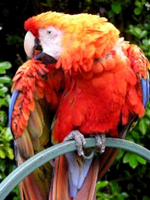 |
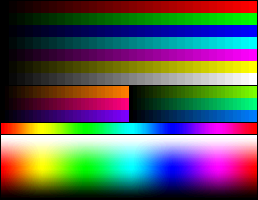 |
Systems with a 15-bit RGB palette use 5 bits for each of the red, green, and blue color components. This results in a 323 = 32,768-color palette (commonly known as Highcolor) as follows:
15-bit systems include:
- Super Nintendo Entertainment SystemSuper Nintendo Entertainment SystemThe Super Nintendo Entertainment System is a 16-bit video game console that was released by Nintendo in North America, Europe, Australasia , and South America between 1990 and 1993. In Japan and Southeast Asia, the system is called the , or SFC for short...
- TruevisionTruevisionTruevision, Inc. was a maker of digital video processing add-on boards for PC computers. It was founded by Cathleen Asch, Carl Calabria, Joseph Haaf, Bryan Hunt, Brad Pillow, Joe Shepard and Jeff Walters and others when AT&T split off their Electronic Photography and Imaging Center in 1987...
TARGATargaTarga is an old word for targe, shield. Targa or TARGA may also refer to:Car rallies*Targa Florio, Sicily, Italy*Targa Canada West, Canada*Targa New Zealand*Targa Newfoundland, Canada*Targa Tasmania, Australia*Targa West, Western Australia...
and AT-Vista graphic cards for IBM PC-AT and compatibles, and NU-Vista for Apple Macintosh - Later models of Super VGA (SVGA) IBM PC compatibleIBM PC compatibleIBM PC compatible computers are those generally similar to the original IBM PC, XT, and AT. Such computers used to be referred to as PC clones, or IBM clones since they almost exactly duplicated all the significant features of the PC architecture, facilitated by various manufacturers' ability to...
graphic cards - NintendoNintendois a multinational corporation located in Kyoto, Japan. Founded on September 23, 1889 by Fusajiro Yamauchi, it produced handmade hanafuda cards. By 1963, the company had tried several small niche businesses, such as a cab company and a love hotel....
Game Boy ColorGame Boy ColorThe is Nintendo's successor to the 8-bit Game Boy handheld game console, and was released on October 21, 1998 in Japan, November 19, 1998 in North America, November 23, 1998 in Europe and November 27, 1998 in the United Kingdom. It features a color screen and is slightly thicker and taller than...
/AdvanceGame Boy AdvanceThe is a 32-bit handheld video game console developed, manufactured, and marketed by Nintendo. It is the successor to the Game Boy Color. It was released in Japan on March 21, 2001; in North America on June 11, 2001; in Australia and Europe on June 22, 2001; and in the People's Republic of China...
/SP/MicroGame Boy Microis a handheld game console developed and manufactured by Nintendo. It was first released in September 2005 in the market. The system is the last console of the Game Boy line...
pocket videoconsoles - Nintendo DSNintendo DSThe is a portable game console produced by Nintendo, first released on November 21, 2004. A distinctive feature of the system is the presence of two separate LCD screens, the lower of which is a touchscreen, encompassed within a clamshell design, similar to the Game Boy Advance SP...
(2D output) - Neo Geo AES/Neo Geo CDNeo Geo CDis a game console from SNK that was released in 1994, four years after its cartridge-based equivalent, in an effort to reduce manufacturing costs. It is the second console of the Neo Geo family. The system was originally priced at US$300 new. The unit's 1X CD-ROM drive was slow, making loading...
videogame consoles
18-bit RGB
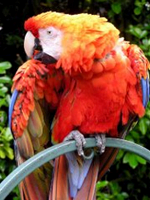 |
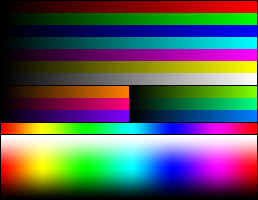 |
Systems with an 18-bit RGB palette use 6 bits for each of the red, green, and blue color components. This results in a 643 = 262,144-color palette as follows:
18-bit RGB systems include the following:
- Video Graphics ArrayVideo Graphics ArrayVideo Graphics Array refers specifically to the display hardware first introduced with the IBM PS/2 line of computers in 1987, but through its widespread adoption has also come to mean either an analog computer display standard, the 15-pin D-subminiature VGA connector or the 640×480 resolution...
(VGA) for IBM PS/2IBM Personal System/2The Personal System/2 or PS/2 was IBM's third generation of personal computers. The PS/2 line, released to the public in 1987, was created by IBM in an attempt to recapture control of the PC market by introducing an advanced proprietary architecture...
and IBM PC compatibleIBM PC compatibleIBM PC compatible computers are those generally similar to the original IBM PC, XT, and AT. Such computers used to be referred to as PC clones, or IBM clones since they almost exactly duplicated all the significant features of the PC architecture, facilitated by various manufacturers' ability to...
s - Atari FalconAtari FalconThe Atari Falcon030 Computer System was Atari Corporation's final computer product. Codenamed Sparrow, the machine was based on a Motorola 68030 main CPU, and had a Motorola 56000 digital signal processor, a feature which distinguished it from most other microcomputers of the era.-History:The...
, which has a video mode displaying 256, 32768 and 65536 out of 262,144 colors - Nintendo DSNintendo DSThe is a portable game console produced by Nintendo, first released on November 21, 2004. A distinctive feature of the system is the presence of two separate LCD screens, the lower of which is a touchscreen, encompassed within a clamshell design, similar to the Game Boy Advance SP...
(3D output and 2D blended output)
24-bit RGB
 |
 |
Often known as truecolor and millions of colors, 24-bit color is the highest color depth normally used, and is available on most modern display systems and software. Its color palette contains 2563 = 16,777,216 colors. This is approximately the number of colors the human eye can distinguish .
The complete palette needs a squared image of 4,096 pixels wide (50MB in memory), and there is not enough room in this page to show it at full. An image of the full palette can be found here.
This can be imagined as 256 stacked squares like the following, every one of them having the same given value for the red component, from 0 to 255.
The color transitions in these patches must be seen as continuous. If you see color stepping (banding
Posterization
Posterization of an image entails conversion of a continuous gradation of tone to several regions of fewer tones, with abrupt changes from one tone to another. This was originally done with photographic processes to create posters...
) inside, then probably your display is using a Highcolor (15- or 16- bits RGB, 32,768 or 65,536 colors) mode or lesser.
 Red = 0 Red = 0 |
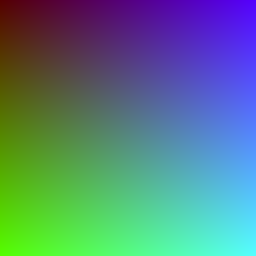 Red = 85 (1/3 of 255) Red = 85 (1/3 of 255) |
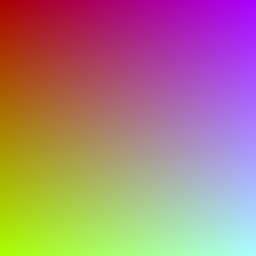 Red = 170 (2/3 of 255) Red = 170 (2/3 of 255) |
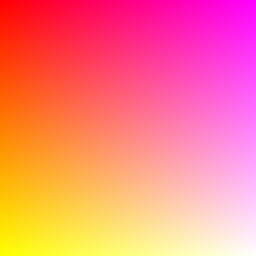 Red = 255 Red = 255 |
This is also the number of colors used in true color image files, like Truevision TGA
Truevision TGA
Truevision TGA, often referred to as TARGA, is a raster graphics file format created by Truevision Inc. . It was the native format of TARGA and VISTA boards, which were the first graphic cards for IBM-compatible PCs to support Highcolor/truecolor display...
, TIFF, JPEG
JPEG
In computing, JPEG . The degree of compression can be adjusted, allowing a selectable tradeoff between storage size and image quality. JPEG typically achieves 10:1 compression with little perceptible loss in image quality....
(the last internally encoded as YCbCr
YCbCr
YCbCr or Y′CbCr, sometimes written or , is a family of color spaces used as a part of the color image pipeline in video and digital photography systems. Y′ is the luma component and CB and CR are the blue-difference and red-difference chroma components...
) and Windows Bitmap
Windows bitmap
The BMP File Format, also known as Bitmap Image File or Device Independent Bitmap file format or simply a Bitmap, is a Raster graphics image file format used to store bitmap digital images, independently of the display device , especially on Microsoft Windows and OS/2 operating systems.The BMP...
, captured with scanner
Image scanner
In computing, an image scanner—often abbreviated to just scanner—is a device that optically scans images, printed text, handwriting, or an object, and converts it to a digital image. Common examples found in offices are variations of the desktop scanner where the document is placed on a glass...
s and digital camera
Digital camera
A digital camera is a camera that takes video or still photographs, or both, digitally by recording images via an electronic image sensor. It is the main device used in the field of digital photography...
s, as well as those created with 3D computer graphics software.
24-bit RGB systems include:
- Amiga Advanced Graphics ArchitectureAdvanced Graphics ArchitectureAdvanced Graphics Architecture is the third generation Amiga graphic chip set, first used in the Amiga 4000 in 1992. AGA was codenamed the Pandora chipset by Commodore International internally....
(AGA) which has a video mode displaying 256 out of 24-bit color - NintendoNintendois a multinational corporation located in Kyoto, Japan. Founded on September 23, 1889 by Fusajiro Yamauchi, it produced handmade hanafuda cards. By 1963, the company had tried several small niche businesses, such as a cab company and a love hotel....
3DS - Later models of Super VGA (SVGA) IBM PC compatibleIBM PC compatibleIBM PC compatible computers are those generally similar to the original IBM PC, XT, and AT. Such computers used to be referred to as PC clones, or IBM clones since they almost exactly duplicated all the significant features of the PC architecture, facilitated by various manufacturers' ability to...
graphic cards - TruevisionTruevisionTruevision, Inc. was a maker of digital video processing add-on boards for PC computers. It was founded by Cathleen Asch, Carl Calabria, Joseph Haaf, Bryan Hunt, Brad Pillow, Joe Shepard and Jeff Walters and others when AT&T split off their Electronic Photography and Imaging Center in 1987...
AT-Vista graphic cards for IBM PC-AT and compatibles, and NU-Vista for Apple Macintosh. - All home video game consoles produced after 1992
30-bit RGB
| (No simulation available) |
Some newer graphics cards support 30-bit RGB and higher. Its color palette contains 10243 = 1,073,741,824 colors. However, there are few operating systems nor applications that support this mode yet. For some people, it may be hard to distinguish between higher color pallets than 24-bit color offers. However, the range of luminance
Luminance
Luminance is a photometric measure of the luminous intensity per unit area of light travelling in a given direction. It describes the amount of light that passes through or is emitted from a particular area, and falls within a given solid angle. The SI unit for luminance is candela per square...
, or grey scale, offered in a 30-bit color system would have 1,024 levels of luminance rather than the 256 of the common standard 24-bit, which the human eye notices more than what hue a color is.
Non-regular RGB palettes
These also are full RGB palette repertories, but either they do not have the same number of levels for every red, green and blue components, nor are bit levels based. Nevertheless, all of them are used in very popular personal computerPersonal computer
A personal computer is any general-purpose computer whose size, capabilities, and original sales price make it useful for individuals, and which is intended to be operated directly by an end-user with no intervening computer operator...
s.
For further details on color palettes for these systems, see the article List of 8-bit computer hardware palettes.
4-bit RGBI
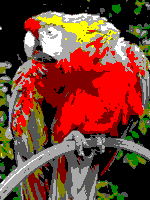 |
 |
The 4-bit RGBI palette is similar to the 3-bit RGB palette but adds one bit for intensity. This results in each of the colors of the 3-bit palette to have a dark and bright variant giving a total of 23×2 = 16 colors.
This 4-bits RGBI schema is used in several platforms with variations, so the table given below is a simple reference for the palette richness, and not an actual implemented palette. For this reason, no numbers are assigned to each color, and color order is arbitrary.
The 4-bits RGBI palettes are used by:
- Color Graphics AdapterColor Graphics AdapterThe Color Graphics Adapter , originally also called the Color/Graphics Adapter or IBM Color/Graphics Monitor Adapter, introduced in 1981, was IBM's first color graphics card, and the first color computer display standard for the IBM PC....
(on the IBM PCIBM PCThe IBM Personal Computer, commonly known as the IBM PC, is the original version and progenitor of the IBM PC compatible hardware platform. It is IBM model number 5150, and was introduced on August 12, 1981...
and compatibles, with brown instead of dark yellow) - EGAEnhanced Graphics AdapterThe Enhanced Graphics Adapter is the IBM PC computer display standard specification which is between CGA and VGA in terms of color and space resolution. Introduced in October 1984 by IBM shortly after its new PC/AT, EGA produces a display of 16 simultaneous colors from a palette of 64 at a...
, VGAVideo Graphics ArrayVideo Graphics Array refers specifically to the display hardware first introduced with the IBM PS/2 line of computers in 1987, but through its widespread adoption has also come to mean either an analog computer display standard, the 15-pin D-subminiature VGA connector or the 640×480 resolution...
and Microsoft WindowsMicrosoft WindowsMicrosoft Windows is a series of operating systems produced by Microsoft.Microsoft introduced an operating environment named Windows on November 20, 1985 as an add-on to MS-DOS in response to the growing interest in graphical user interfaces . Microsoft Windows came to dominate the world's personal...
as their default 16-color CGAColor Graphics AdapterThe Color Graphics Adapter , originally also called the Color/Graphics Adapter or IBM Color/Graphics Monitor Adapter, introduced in 1981, was IBM's first color graphics card, and the first color computer display standard for the IBM PC....
-compatible palette. (Dark yellow had a reduced green level and thus was brown instead of the ochre shown above.) - MOS Technology VDC (on the Commodore 128Commodore 128The Commodore 128 home/personal computer was the last 8-bit machine commercially released by Commodore Business Machines...
) - ZX SpectrumZX SpectrumThe ZX Spectrum is an 8-bit personal home computer released in the United Kingdom in 1982 by Sinclair Research Ltd...
(with two black, black with bright is the same as black without bright) - TI 99/4A
3-level RGB
 |
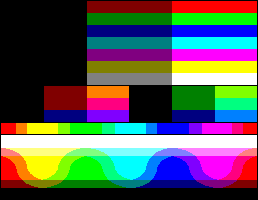 |
The 3-level (not bits) RGB uses three level for every red, green and blue color components, resulting in a 33 = 27 colors palette as follows:
This palette is used by the Amstrad CPC 464 series of personal computers.
3-3-2 bit RGB
 |
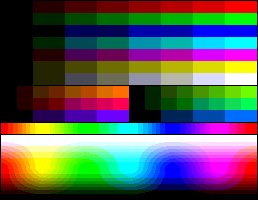 |
The 3-3-2 bit RGB use 3 bits for each of the red and green color components, and 2 bits for the blue component, due to the lesser sensitivity of the normal human eye to this primary color. This results in a 8×8×4 = 256-color palette as follows:
This palette is used by
- The MSX2 series of personal computers.
- Palette 4 of the IBM PGCProfessional Graphics ControllerProfessional Graphics Controller was a graphics card manufactured by IBM for the PC. It consisted of three interconnected PCBs, and contained its own processor and memory....
(palette 2 gives 2-3-3 bit RGB and palette 3 gives 3-2-3 bit RGB). - VGA built-in output of the Digilent Inc. NEXYS 2 and BASYS2 FPGA boards.
- The UzeboxUzeboxThe Uzebox is a retro-minimalist open source video game console design. It is based on an AVR 8-bit general-purpose microcontroller made by Atmel. The particularity of the system is that it uses an interrupt-driven kernel and has no frame buffer...
gaming console
16-bit RGB
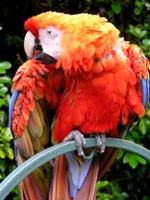 |
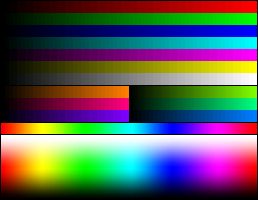 |
Most modern systems support 16-bit color. It is sometimes referred to as Highcolor (along with the 15-bit RGB), medium color or thousands of colors. It utilizes a color palette of 32×64×32 = 65,536 colors. Usually, there are 5 bits allocated for the red and blue color components (32 levels each) and 6 bits for the green component (64 levels), due to the greater sensitivity of the normal human eye to this color. This doubles the 15-bit RGB palette.
The 16-bit RGB palette using 6 bits for the green component:
The Extended Graphics Array (XGA) for IBM PS/2
IBM Personal System/2
The Personal System/2 or PS/2 was IBM's third generation of personal computers. The PS/2 line, released to the public in 1987, was created by IBM in an attempt to recapture control of the PC market by introducing an advanced proprietary architecture...
also uses the 16-bit RGB palette.
It must be noticed that not all systems using 16-bit color depth employ the 16-bit, 32-64-32 level RGB palette. Platforms like Sharp X68000
Sharp X68000
The Sharp X68000, often referred to as the X68k, is a home computer released only in Japan by the Sharp Corporation. The first model was released in 1987, with a 10 MHz Motorola 68000 CPU, 1 MB of RAM and no hard drive; the last model was released in 1993 with a 25 MHz Motorola 68030...
or the Neo Geo
Neo Geo (console)
The is a cartridge-based arcade and home video game system released on July 1, 1991 by Japanese game company SNK. Being in the Fourth generation of Gaming, it was the first console in the former Neo Geo family, which only lived through the 1990s...
videogame console employs the 15-bit RGB palette (5 bits are used for red, green, and blue), but the last bit specifies a less significant intensity or luminance. The 16-bit mode of the Truevision
Truevision
Truevision, Inc. was a maker of digital video processing add-on boards for PC computers. It was founded by Cathleen Asch, Carl Calabria, Joseph Haaf, Bryan Hunt, Brad Pillow, Joe Shepard and Jeff Walters and others when AT&T split off their Electronic Photography and Imaging Center in 1987...
TARGA
Truevision TGA
Truevision TGA, often referred to as TARGA, is a raster graphics file format created by Truevision Inc. . It was the native format of TARGA and VISTA boards, which were the first graphic cards for IBM-compatible PCs to support Highcolor/truecolor display...
/AT-Vista/NU-Vista graphic cards and its associated TGA file format also uses 15-bit RGB, but it devotes its remaining bit as a simple alpha channel for video overlay.
See also
- Palette (computing)Palette (computing)In computer graphics, a palette is either a given, finite set of colors for the management of digital images , or a small on-screen graphical element for choosing from a limited set of choices, not necessarily colors .Depending on the context In computer graphics, a palette is either a given,...
- Indexed colorIndexed colorIn computing, indexed color is a technique to manage digital images' colors in a limited fashion, in order to save computer memory and file storage, while speeding up display refresh and file transfers...
- Color Lookup TableCLUTA colour look-up table is a mechanism used to transform a range of input colours into another range of colours. It can be a hardware device built into an imaging system or a software function built into an image processing application...
- Color depthColor depthIn computer graphics, color depth or bit depth is the number of bits used to represent the color of a single pixel in a bitmapped image or video frame buffer. This concept is also known as bits per pixel , particularly when specified along with the number of bits used...
- Computer displayComputer displayA monitor or display is an electronic visual display for computers. The monitor comprises the display device, circuitry, and an enclosure...
- List of home computers by video hardware
- BitmapBitmapIn computer graphics, a bitmap or pixmap is a type of memory organization or image file format used to store digital images. The term bitmap comes from the computer programming terminology, meaning just a map of bits, a spatially mapped array of bits. Now, along with pixmap, it commonly refers to...
- GrayscaleGrayscaleIn photography and computing, a grayscale or greyscale digital image is an image in which the value of each pixel is a single sample, that is, it carries only intensity information...
- RGB
External links and sources
- HTML Color Codes Dynamic color palette with HTML color codes information









